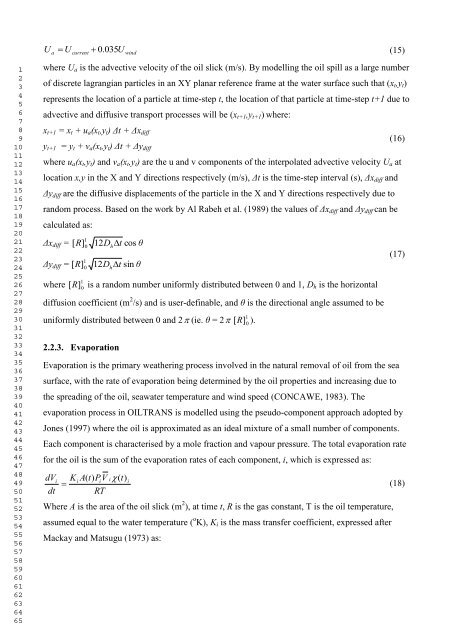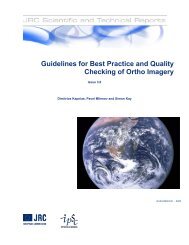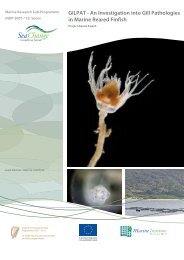1234567891011121314151617181920212223242526272829303132333435363738394041424344454647484950515253545556575859606162636465x = (cosφ)x * +(sinφ)y *(14)y = (-sinφ)x * +(cosφ)y *where φ is <strong>the</strong> angle between <strong>the</strong> wind direction <strong>and</strong> <strong>the</strong> positive x-axis of <strong>the</strong> <strong>OILTRANS</strong> <strong>model</strong>domain. After each time-step in <strong>the</strong> <strong>OILTRANS</strong> <strong>model</strong>, <strong>the</strong> centre of mass of <strong>the</strong> <strong>oil</strong> slick is recalculated<strong>and</strong> becomes <strong>the</strong> origin of a new local coordinate system for a new set of concentricellipses, <strong>the</strong> extent of which is calculated from equations (5) <strong>and</strong> (6).<strong>The</strong> classical Fay (1971) formulation for mechanical spreading, in <strong>the</strong> absence of wind effects, isalso encoded in <strong>the</strong> <strong>OILTRANS</strong> system for sensitivity analyses <strong>and</strong> <strong>to</strong> give end users <strong>the</strong> options <strong>to</strong>choose an alternative algorithm for local implementations.<strong>The</strong> calculation of <strong>the</strong> elliptical spreadingof <strong>the</strong> <strong>oil</strong> slick is undertaken during <strong>the</strong> gravity-viscous phase of <strong>the</strong> spreading of <strong>the</strong> <strong>oil</strong> slick <strong>and</strong>only until <strong>the</strong> terminal <strong>oil</strong> slick thickness is reached. Once <strong>the</strong> terminal <strong>oil</strong> slick thickness is reached<strong>the</strong> spreading assumption is removed <strong>and</strong> <strong>the</strong> slick is allowed <strong>to</strong> spread under <strong>the</strong> influence ofhorizontal diffusion, surface winds <strong>and</strong> water current shears, as detailed below, <strong>to</strong> representcomplex, realistic surface slicks.2.2.2. Advection <strong>and</strong> diffusion.<strong>The</strong> movement of an <strong>oil</strong> slick at <strong>the</strong> water surface can be considered as being composed of <strong>the</strong>advection of <strong>the</strong> <strong>oil</strong> slick by both surface currents (U current ) , wind effects (U wind ), <strong>and</strong> <strong>the</strong> diffusionof <strong>oil</strong> particles as a result of r<strong>and</strong>om processes (ASCE 1996; Ambjorn 2007; Guo et al 2009;Carracedo 2006, Cheng, 2011, Jordi et al 2006). <strong>The</strong> advection of <strong>the</strong> <strong>oil</strong> slick due <strong>to</strong> surfacecurrents is taken <strong>to</strong> be <strong>the</strong> current velocity as predicted in <strong>the</strong> surface layer of <strong>the</strong> water column by<strong>the</strong> authors‟ oceanographic <strong>model</strong>, U current ,.<strong>The</strong>re are a number of processes that are associated with wind effects <strong>and</strong> most <strong>oil</strong> <strong>spill</strong> <strong>model</strong>srepresent <strong>the</strong>m with a simple wind drift fac<strong>to</strong>r (Guo & Wang, 2009; French McKay, 2004;Nagheeby <strong>and</strong> Kolahdoozan, 2008, Perianez, 2010). Most oceanographic <strong>model</strong>s do not adequatelyresolve <strong>the</strong> uppermost centimeter of <strong>the</strong> water column at <strong>the</strong> air-water interface <strong>and</strong> thus tend <strong>to</strong>underpredict <strong>the</strong> actual wind induced surface current. Allowance is made for this throughincorporation in<strong>to</strong> <strong>the</strong> wind drift fac<strong>to</strong>r, as in Ambjorn (2007). Based on sensitivity testing <strong>the</strong>cumulative wind drift fac<strong>to</strong>r was set at 3.5% of <strong>the</strong> wind speed, which is in keeping with valuesfound in published literature (Carracedo 2006; Guo & Wang, 2009; French McKay, 2004; Perianez,2010)rench-McKayBIn addition <strong>to</strong> <strong>the</strong> advective wind drift fac<strong>to</strong>r, a Coriolis force correction is alsointroduced, whereby <strong>the</strong> surface slick is deflected <strong>to</strong> <strong>the</strong> right by a drift angle, which is set <strong>to</strong> 5 o .It follows <strong>the</strong>refore that <strong>the</strong> centre of mass of <strong>the</strong> <strong>oil</strong> slick is advected by surface currents <strong>and</strong> windeffects according <strong>to</strong>:
1234567891011121314151617181920212223242526272829303132333435363738394041424344454647484950515253545556575859606162636465U U 0. 035U(15)acurrentwindwhere U a is <strong>the</strong> advective velocity of <strong>the</strong> <strong>oil</strong> slick (m/s). By <strong>model</strong>ling <strong>the</strong> <strong>oil</strong> <strong>spill</strong> as a large numberof discrete lagrangian particles in an XY planar reference frame at <strong>the</strong> water surface such that (x t ,y t )represents <strong>the</strong> location of a particle at time-step t, <strong>the</strong> location of that particle at time-step t+1 due <strong>to</strong>advective <strong>and</strong> diffusive transport processes will be (x t+1 ,y t+1 ) where:x t+1 = x t + u a (x t ,y t ) Δt + Δx diffy t+1 = y t + v a (x t ,y t ) Δt + Δy diffwhere u a (x t ,y t ) <strong>and</strong> v a (x t ,y t ) are <strong>the</strong> u <strong>and</strong> v components of <strong>the</strong> interpolated advective velocity U a atlocation x,y in <strong>the</strong> X <strong>and</strong> Y directions respectively (m/s), Δt is <strong>the</strong> time-step interval (s), Δx diff <strong>and</strong>Δy diff are <strong>the</strong> diffusive displacements of <strong>the</strong> particle in <strong>the</strong> X <strong>and</strong> Y directions respectively due <strong>to</strong>r<strong>and</strong>om process. Based on <strong>the</strong> work by Al Rabeh et al. (1989) <strong>the</strong> values of Δx diff <strong>and</strong> Δy diff can becalculated as:1Δx diff = [ R]12D hcos θ0t(17)1Δy diff = [ R]12D hsin θwhere0t1[R] 0is a r<strong>and</strong>om number uniformly distributed between 0 <strong>and</strong> 1, D h is <strong>the</strong> horizontaldiffusion coefficient (m 2 /s) <strong>and</strong> is user-definable, <strong>and</strong> θ is <strong>the</strong> directional angle assumed <strong>to</strong> beuniformly distributed between 0 <strong>and</strong> 2 (ie. θ = 2 [R ).2.2.3. EvaporationEvaporation is <strong>the</strong> primary wea<strong>the</strong>ring process involved in <strong>the</strong> natural removal of <strong>oil</strong> from <strong>the</strong> seasurface, with <strong>the</strong> rate of evaporation being determined by <strong>the</strong> <strong>oil</strong> properties <strong>and</strong> increasing due <strong>to</strong><strong>the</strong> spreading of <strong>the</strong> <strong>oil</strong>, seawater temperature <strong>and</strong> wind speed (CONCAWE, 1983). <strong>The</strong>evaporation process in <strong>OILTRANS</strong> is <strong>model</strong>led using <strong>the</strong> pseudo-component approach adopted byJones (1997) where <strong>the</strong> <strong>oil</strong> is approximated as an ideal mixture of a small number of components.Each component is characterised by a mole fraction <strong>and</strong> vapour pressure. <strong>The</strong> <strong>to</strong>tal evaporation ratefor <strong>the</strong> <strong>oil</strong> is <strong>the</strong> sum of <strong>the</strong> evaporation rates of each component, i, which is expressed as:dVdtKiA( t)PVi i (ti (18)RTi)Where A is <strong>the</strong> area of <strong>the</strong> <strong>oil</strong> slick (m 2 ), at time t, R is <strong>the</strong> gas constant, T is <strong>the</strong> <strong>oil</strong> temperature,assumed equal <strong>to</strong> <strong>the</strong> water temperature ( o K), K i is <strong>the</strong> mass transfer coefficient, expressed afterMackay <strong>and</strong> Matsugu (1973) as:1] 0(16)
















